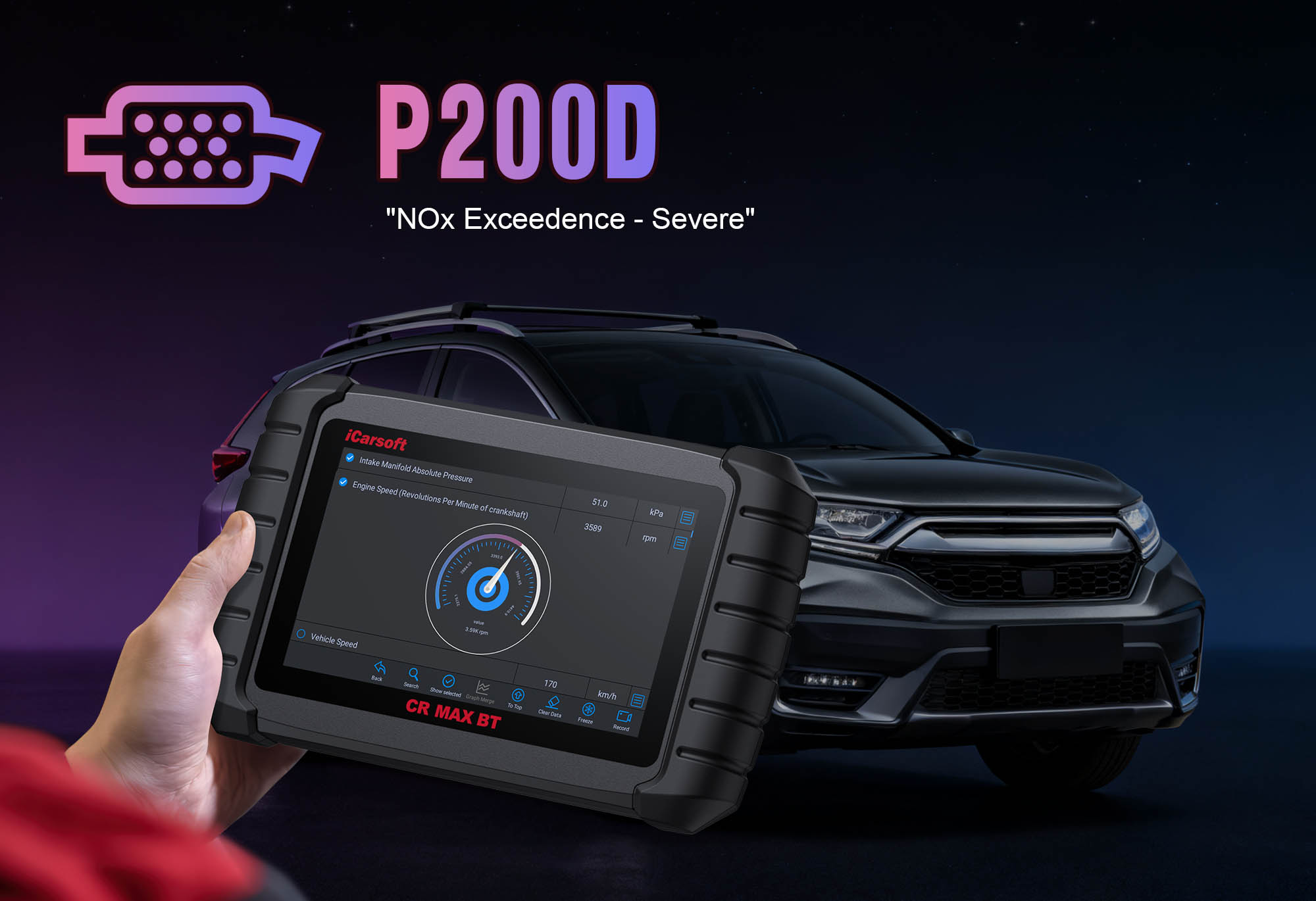Diagnose & Clear P0455 with iCarsoft CR MAX BT: Fix EVAP System Large Leak Issues
If your check engine light illuminates and a scan returns P0455, your vehicle’s Evaporative Emissions (EVAP) system is signaling a critical leak. This generic OBD-II code stands for "Evaporative Emission System Large Leak Detected"—meaning the Engine Control Module (ECM) has found a significant breach in the EVAP system, which captures and recycles fuel vapors from the gas tank to reduce emissions.
The EVAP system is a closed network of hoses, valves (like the Purge Solenoid and Vent Solenoid), a charcoal canister, and a gas cap—all working to prevent fuel vapors from escaping into the atmosphere. A "large leak" (typically ≥0.040 inches) breaks this seal, allowing vapors to leak out and triggering P0455. Left unaddressed, this not only fails emissions tests but can also cause fuel odor inside/outside the vehicle and slightly reduced fuel efficiency.
Basic scanners might only label P0455 as an "EVAP leak" but can’t pinpoint the leak location or distinguish between a loose gas cap, cracked hose, or faulty valve. The iCarsoft CR MAX BT—with its wireless connectivity, EVAP system smoke tests, and real-time solenoid monitoring—solves this. Let’s walk through how to diagnose and resolve P0455.
 iCarsoft CR MAX BT monitoring EVAP system pressure to diagnose P0455
iCarsoft CR MAX BT monitoring EVAP system pressure to diagnose P0455
Understanding P0455: Causes & Key Symptoms
To tackle P0455 effectively, first map its impact on your vehicle’s emissions and performance:
Key Symptoms of P0455
-
Check Engine Light: Illuminates when the ECM’s leak detection pump (LDP) or pressure test fails to maintain vacuum/pressure in the EVAP system.
-
Fuel Odor: Strong gasoline smell inside the cabin (via vents) or outside the vehicle (near the gas tank/charcoal canister).
-
Emissions Test Failure: High hydrocarbon (HC) levels from leaking fuel vapors cause failed state inspections.
-
Slight Fuel Efficiency Drop: Unrecovered fuel vapors reduce overall fuel economy by 2–5%.
-
EVAP Warning Message: Some vehicles (e.g., Ford, Toyota) display "Check EVAP System" or "Loose Gas Cap" on the dashboard.
Common Causes of P0455
|
Cause
|
Description
|
|
Loose/Missing Gas Cap
|
The most frequent cause—even a cap not tightened 3–4 clicks can create a large leak (accounts for ~30% of P0455 cases).
|
|
Cracked EVAP Hoses
|
Dry rot, rodent damage, or heat degradation to hoses connecting the gas tank, charcoal canister, and purge/vent solenoids.
|
|
Faulty EVAP Valves
|
Failed Purge Solenoid (stuck open/closed) or Vent Solenoid (can’t seal the system during pressure tests—breaks vacuum/pressure).
|
|
Damaged Charcoal Canister
|
Rust, impact damage (from road debris), or clogging to the canister (mounted near the rear axle)—creates vapor leaks.
|
|
Gas Tank Issues
|
Cracked tank (from collisions or debris) or loose fuel filler neck gasket—allows vapors to escape before reaching the EVAP system.
|
|
Leak Detection Pump (LDP) Failure
|
Malfunctioning LDP can’t perform pressure/vacuum tests, leading to false P0455 codes (common in 2005+ vehicles).
|
Why iCarsoft CR MAX BT Excels at Diagnosing P0455
The CR MAX BT outperforms basic tools with features tailored to EVAP system diagnostics—plus the flexibility of wireless operation:
EVAP System Deep Scan
Reads fault codes from both the ECM and EVAP control module, not just generic OBD-II data—critical for identifying LDP or solenoid-specific P0455 triggers.
Wireless Smoke Test Activation
Sends commands to the LDP to pressurize the EVAP system, then monitors pressure changes in real time—no need for a separate smoke machine to detect leaks.
Real-Time Solenoid Monitoring
Displays live voltage and activation status of Purge/Vent Solenoids—spots stuck valves by showing inconsistent voltage (e.g., stuck at 0V when should be 12V).
Vehicle-Specific EVAP Diagrams
Preloaded with hose routing, component locations, and test specs for 58+ makes (e.g., Toyota Camry, Ford F-150, Honda Civic)—eliminates guesswork when tracing leaks.
Wireless Convenience
No tangled cables—move freely from the gas cap (to inspect) to the rear axle (to check the canister) while monitoring pressure data on your mobile device.
Dedicated Gas Cap Test
Runs a 2-minute pressure test to verify cap sealing—eliminates the most common P0455 cause in minutes without disassembly.
Step-by-Step: Diagnose P0455 with iCarsoft CR MAX BT
-
1. Connect Wirelessly & Confirm the Code
Plug the CR MAX BT’s OBD-II adapter into your vehicle’s port (under the dashboard), then pair the scanner with the adapter via Bluetooth (follow on-screen prompts for iOS/Android).
Select your vehicle via Auto VIN (scans your VIN in 2 seconds) or manual entry (make/model/year).
Navigate to Engine > Fault Codes > Read Codes to confirm P0455. Tap Code Details for vehicle-specific info (e.g., "Toyota: EVAP System Pressure Drop > 5 kPa in 60 Seconds").
-
2. Check for Related EVAP Codes
P0455 often pairs with other EVAP faults—scan for these to narrow the root cause:
P0440 (EVAP System Malfunction)
P0441 (EVAP Purge Flow Incorrect)
P0442/P0446 (EVAP Small Leak/ Vent Solenoid Fault)
P0452/P0453 (EVAP Pressure Sensor Low/High Voltage)
Multiple codes = systemic EVAP issues (e.g., faulty solenoid + cracked hose) rather than just a loose gas cap.
-
3. Perform the Gas Cap Test First
Since a loose gas cap causes 30% of P0455 cases, start here with the CR MAX BT:
Ensure the gas cap is tightened 3–4 clicks (until you hear a "clicking" sound).
Navigate to Special Functions > EVAP > Gas Cap Test.
The scanner runs a 2-minute pressure test—if it passes, the cap is sealed (move to Step 4).
If it fails: Replace the gas cap with an OEM part (use the CR MAX BT’s Part Lookup for specs) and retest.
-
4. Monitor Live EVAP System Data
The CR MAX BT’s real-time data reveals pressure and solenoid irregularities:
Go to Engine > Live Data > EVAP System and select:
"EVAP System Pressure" (should hold -2 to +2 kPa during tests; rapid drop = leak).
"Purge Solenoid Voltage" (12V when activated, 0V when off—checks if the ECM sends signals).
"Vent Solenoid Voltage" (12V to close, 0V to open—ensures it seals the system).
Start the engine and let it idle:
Pressure drops to -5 kPa or lower = large leak (e.g., cracked hose).
Solenoid voltage stuck at 0V/12V = faulty valve (replace it).
No pressure change = LDP failure (needs repair).
-
5. Run Wireless EVAP Leak Detection Test
The CR MAX BT’s built-in leak test eliminates guesswork:
Ensure the gas tank is 1/4 to 3/4 full (too empty/full affects pressure tests) and the engine is off.
Navigate to Special Functions > EVAP > Leak Detection Test.
Follow on-screen prompts: The scanner activates the LDP to pressurize the EVAP system to 5 kPa.
Monitor the pressure reading for 60 seconds:
Pressure holds steady = no leak (P0455 may be a false code—clear and retest).
Pressure drops >3 kPa = large leak (proceed to locate it).
-
6. Locate the Leak with Visual Inspection & Diagrams
Use the CR MAX BT’s Component Location tool to find key EVAP parts and inspect for damage:
Gas Tank & Filler Neck:
Check for cracks in the tank (look under the rear of the vehicle) or a loose filler neck gasket (replace if brittle).
Charcoal Canister:
Located near the rear axle—inspect for rust holes, disconnected hoses, or rodent damage.
EVAP Hoses:
Follow the CR MAX BT’s EVAP diagram to trace hoses from the canister to the engine bay.
Look for cracks, dry rot, or loose connections—squeeze hoses to check for flexibility (hard/brittle = replace).
Purge/Vent Solenoids:
Purge Solenoid: Mounted on the engine or firewall—check for oil contamination or disconnected wires.
Vent Solenoid: Near the canister—ensure it’s not stuck open (use the CR MAX BT’s solenoid test to confirm).
-
7. Test EVAP Solenoids for Proper Operation
The CR MAX BT’s bi-directional tests confirm if valves work:
Purge Solenoid Test:
Navigate to Special Functions > EVAP > Purge Solenoid Activation.
Activate the solenoid—listen for a faint "click" (indicates it’s opening/closing).
No click + voltage present = faulty solenoid (replace).
Vent Solenoid Test:
Repeat the process for the Vent Solenoid—ensure it seals when activated (pressure should hold during leak tests).
-
8. Check the Leak Detection Pump (LDP)
If pressure tests fail but no leaks are found, test the LDP:
Go to Special Functions > EVAP > LDP Test.
The CR MAX BT commands the LDP to run through pressure cycles—monitor if it reaches 5 kPa.
LDP can’t build pressure = faulty pump (replace it—follow the CR MAX BT’s service manual for steps).
-
9. Repair & Clear P0455
Fix the Root Cause:
Replace a loose/cracked gas cap (OEM recommended).
Repair EVAP hoses: Cut out damaged sections and splice with heat-shrink connectors, or replace entire hoses.
Replace faulty solenoids/pump: Use the CR MAX BT’s Part Lookup for OEM parts (e.g., Dorman 911-081 Purge Solenoid).
Fix a cracked tank/canister: Consult a professional if welding is needed (small cracks may use EVAP sealant).
Clear the Code: Navigate to Engine > Fault Codes > Clear Codes to delete P0455 and related EVAP faults.
-
10. Verify the Repair
Perform a final test to ensure the EVAP system is sealed:
Re-run the EVAP Leak Detection Test—pressure should hold steady for 60 seconds.
Take a 20-minute test drive (include highway speeds) to allow the ECM to recheck the EVAP system.
Re-scan for codes: No return of P0455 + no fuel odor = successful repair.
Emissions Prep: If you have an upcoming test, use the CR MAX BT’s Readiness Monitors to confirm the EVAP monitor is "Ready."
Preventing P0455 Recurrence
The CR MAX BT helps maintain a healthy EVAP system long-term:
-
Gas Cap Care: Tighten the cap 3–4 clicks every time you refuel—use the CR MAX BT’s Gas Cap Reminder to avoid forgetting.
-
Hose Inspections: Check EVAP hoses during oil changes—replace brittle ones before they crack.
-
Rodent Protection: Park away from tall grass/bushes; use rodent repellent near the engine bay (avoid damaging wires/hoses).
-
Canister Maintenance: Keep the charcoal canister free of debris—clean it with compressed air annually (follow the CR MAX BT’s guide).
-
Readiness Monitors Check: Use the CR MAX BT to verify the EVAP monitor is "Ready" before emissions tests—avoids test failures.
Conclusion
P0455’s link to emissions compliance and fuel efficiency makes it a key fault to resolve, but the iCarsoft CR MAX BT simplifies diagnosis with wireless convenience and EVAP-specific tools. Whether you’re tightening a gas cap, replacing a solenoid, or locating a cracked hose, the CR MAX BT ensures you resolve the root cause—restoring emissions compliance, eliminating fuel odors, and protecting your vehicle’s performance.
With this guide, you’ll turn a vague "EVAP leak" code into a straightforward repair—no tangled cables, no guesswork, just confidence in your vehicle’s emissions system.
FAQs About P0455 Code
Q: Can I drive my vehicle with P0455?
A: Yes, P0455 is not an immediate safety hazard. However, it will cause your vehicle to fail emissions tests and may lead to a fuel odor. It’s best to fix it within a few weeks to avoid potential state inspection issues.
Q: Why does P0455 come and go?
A: Intermittent P0455 often occurs with small cracks in hoses that expand/contract with temperature changes. Cold weather can make cracks larger (triggering the code), while heat may seal them temporarily. The CR MAX BT’s pressure test will detect these even when the code isn’t active.
Q: How much does it cost to fix P0455?
A: Costs vary: Gas cap replacement = $15–$30 (DIY); EVAP hose repair = $10–$50 (DIY); Solenoid replacement = $40–$120 (DIY); Charcoal canister = $150–$400 (professional). Professional labor adds $100–$200—save by using the CR MAX BT to diagnose first.
Q: Will clearing P0455 make it go away permanently?
A: No—clearing the code only resets the check engine light temporarily. The ECM will re-test the EVAP system within 20–50 miles of driving, and P0455 will return if the leak isn’t fixed. Always repair the root cause before clearing the code.

 iCarsoft CR MAX BT monitoring EVAP system pressure to diagnose P0455
iCarsoft CR MAX BT monitoring EVAP system pressure to diagnose P0455



